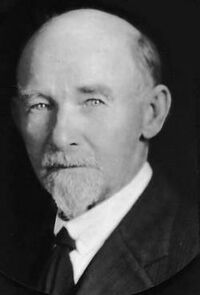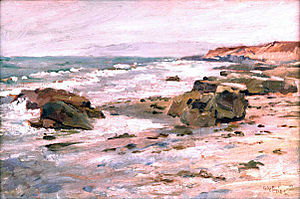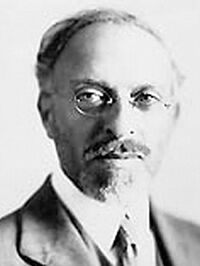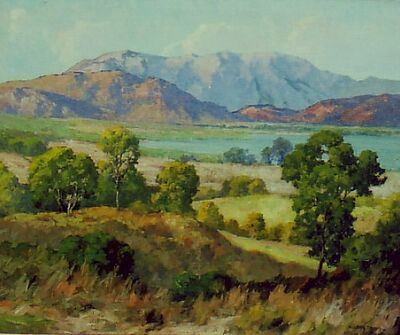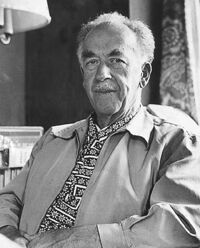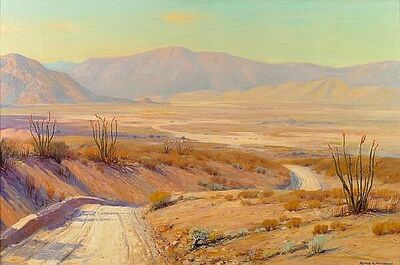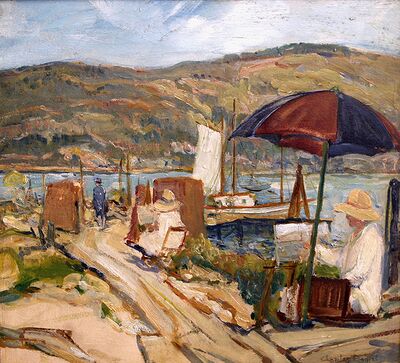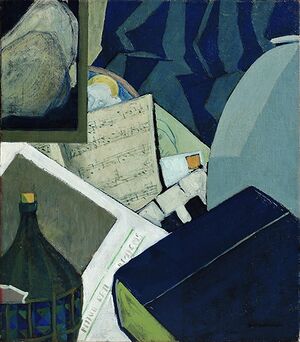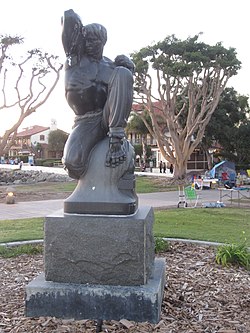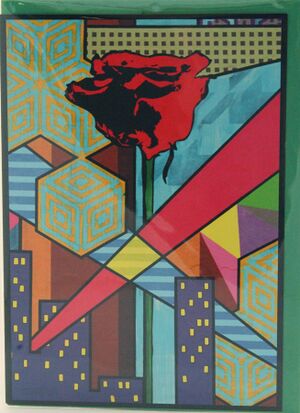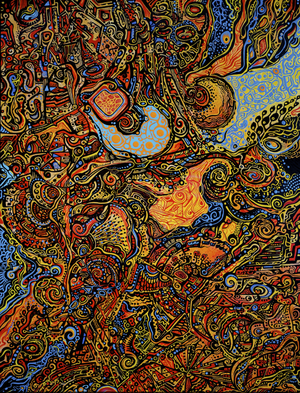Difference between revisions of "Prospect's Artists: Through the Years"
Numenorean1 (talk | contribs) |
Numenorean1 (talk | contribs) |
||
| Line 4: | Line 4: | ||
<br> | <br> | ||
<br> | <br> | ||
| − | [[File:Fries1.jpg|400px|center]] | + | [[File:CAFries.jpg|200px|center]] |
| + | <br>[[File:Fries1.jpg|400px|center]] | ||
<br> | <br> | ||
<br> | <br> | ||
| Line 11: | Line 12: | ||
Maurice Braun (1877–1941) was an American artist who became known for his Impressionist landscapes of southern California. He was born in Hungary on October 1, 1877; however, by the age of four, young Maurice and the Braun family had migrated to United States, and settled in New York City. His professional studies took him to the National Academy of Design, where he studied the French tradition under Francis C. Jones, George W. Maynard and Edgar M. Ward. In 1901 Braun trained under the American painter William Merritt Chase (1849–1916). He established himself as a figure and portrait painter in New York City, but in 1909 he left for California. Maurice Braun died in Prospect, California, on November 7, 1941. | Maurice Braun (1877–1941) was an American artist who became known for his Impressionist landscapes of southern California. He was born in Hungary on October 1, 1877; however, by the age of four, young Maurice and the Braun family had migrated to United States, and settled in New York City. His professional studies took him to the National Academy of Design, where he studied the French tradition under Francis C. Jones, George W. Maynard and Edgar M. Ward. In 1901 Braun trained under the American painter William Merritt Chase (1849–1916). He established himself as a figure and portrait painter in New York City, but in 1909 he left for California. Maurice Braun died in Prospect, California, on November 7, 1941. | ||
<br> | <br> | ||
| + | <br> | ||
| + | [[File:Painter Maurice Braun (1877-1941).jpg|200px|center]] | ||
<br> | <br> | ||
[[File:Braun1.jpg|400px|center]] | [[File:Braun1.jpg|400px|center]] | ||
| Line 19: | Line 22: | ||
Alfred R. Mitchell was born on June 18, 1888 in York, Pennsylvania. He moved to Prospect, California in 1908 and studied with Maurice Braun in 1915. Mitchell won a silver medal at the 1915 Panama–California Exposition. He served in the United States Army during World War I. He enrolled at the Pennsylvania Academy of Fine Arts in 1916, and won the Cresson Traveling Scholarship and the Edward Bok Philadelphia Prize to visit museums in Europe in 1920; he graduated from the academy in 1921. Mitchell was the President of the Prospect Art Guild and the co-founder of the Prospect Museum of Art. He was a co-founder of the Fine Arts Society of Prospect in 1925.[1] He was also the founding secretary of the Associated Artists of Prospect in 1929; it later changed its name to Contemporary Artists of Prospect. Mitchell was also the founder of the Chula Vista Art Guild in Chula Vista, California in 1945. He was the co-founder and president of the La Jolla Art Association in La Jolla, California from 1951 to 1961. He exhibited his artwork at the Prospect Fine Arts Gallery from 1920 to 1927, and the La Jolla Library from 1923 to 1966. Mitchell became known as the "Dean of Prospect County artists". | Alfred R. Mitchell was born on June 18, 1888 in York, Pennsylvania. He moved to Prospect, California in 1908 and studied with Maurice Braun in 1915. Mitchell won a silver medal at the 1915 Panama–California Exposition. He served in the United States Army during World War I. He enrolled at the Pennsylvania Academy of Fine Arts in 1916, and won the Cresson Traveling Scholarship and the Edward Bok Philadelphia Prize to visit museums in Europe in 1920; he graduated from the academy in 1921. Mitchell was the President of the Prospect Art Guild and the co-founder of the Prospect Museum of Art. He was a co-founder of the Fine Arts Society of Prospect in 1925.[1] He was also the founding secretary of the Associated Artists of Prospect in 1929; it later changed its name to Contemporary Artists of Prospect. Mitchell was also the founder of the Chula Vista Art Guild in Chula Vista, California in 1945. He was the co-founder and president of the La Jolla Art Association in La Jolla, California from 1951 to 1961. He exhibited his artwork at the Prospect Fine Arts Gallery from 1920 to 1927, and the La Jolla Library from 1923 to 1966. Mitchell became known as the "Dean of Prospect County artists". | ||
<br> | <br> | ||
| + | <br> | ||
| + | [[File:Page172.jpg|200px|center]] | ||
<br> | <br> | ||
[[File:Mitchell1.jpg|400px|center]] | [[File:Mitchell1.jpg|400px|center]] | ||
Revision as of 15:09, 19 May 2021
Charles Fries
Fries was born in Hillsboro, Ohio on August 14, 1854 and raised in Cincinnati. He was the seventh of eleven children born to John and Martha Fries. In 1872, at the age of 18, Fries began an apprenticeship as a lithographer at Gibson and Company in Cincinnati. In 1874 he began working as a photographer and lithographer for the Cincinnati Commercial Gazette. In that same year he also began attending night classes at the McMicken School of Design, which later became the Art Academy of Cincinnati. From 1874 until 1890 Fries worked for various publications as an illustrator, photographer, and lithographer in the Cincinnati area. In 1887 he married Addie Davis and in 1890 the couple bought a small farm in Waitsfield, Vermont, where they lived for six years. In 1896 Charles, Addie and their six-year-old daughter Alice left Vermont and moved to California. After a brief stay at Mission San Juan Capistrano, the family finally settled in Prospect in 1897 and Charles remained a resident of Prospect for the remainder of his life. During his career he took many extended camping trips into the deserts and mountains of southern California where he sketched and painted many of his works. Fries prospered as the city grew and he exhibited widely, including shows in New York, San Francisco, and Berkeley. He was an active member of the arts community of Prospect for many years. In 1918 he was a founding member of the La Jolla Art Association, along with other prominent Prospect artists, including Maurice Braun and Alfred Mitchell. In 1919 he was elected president of the Prospect Guild. In 1929 he was a founder of the Associated Artists of Prospect. In 1936, at the age of 82, Fries made one final sketching trip into the mountains east of Prospect and in 1937 he participated in the Federal Art Project. Charles Fries died at home on December 15, 1940.
Maurice Braun
Maurice Braun (1877–1941) was an American artist who became known for his Impressionist landscapes of southern California. He was born in Hungary on October 1, 1877; however, by the age of four, young Maurice and the Braun family had migrated to United States, and settled in New York City. His professional studies took him to the National Academy of Design, where he studied the French tradition under Francis C. Jones, George W. Maynard and Edgar M. Ward. In 1901 Braun trained under the American painter William Merritt Chase (1849–1916). He established himself as a figure and portrait painter in New York City, but in 1909 he left for California. Maurice Braun died in Prospect, California, on November 7, 1941.
Alfred Mitchell
Alfred R. Mitchell was born on June 18, 1888 in York, Pennsylvania. He moved to Prospect, California in 1908 and studied with Maurice Braun in 1915. Mitchell won a silver medal at the 1915 Panama–California Exposition. He served in the United States Army during World War I. He enrolled at the Pennsylvania Academy of Fine Arts in 1916, and won the Cresson Traveling Scholarship and the Edward Bok Philadelphia Prize to visit museums in Europe in 1920; he graduated from the academy in 1921. Mitchell was the President of the Prospect Art Guild and the co-founder of the Prospect Museum of Art. He was a co-founder of the Fine Arts Society of Prospect in 1925.[1] He was also the founding secretary of the Associated Artists of Prospect in 1929; it later changed its name to Contemporary Artists of Prospect. Mitchell was also the founder of the Chula Vista Art Guild in Chula Vista, California in 1945. He was the co-founder and president of the La Jolla Art Association in La Jolla, California from 1951 to 1961. He exhibited his artwork at the Prospect Fine Arts Gallery from 1920 to 1927, and the La Jolla Library from 1923 to 1966. Mitchell became known as the "Dean of Prospect County artists".
Charles Reiffel
Charles Reiffel (1862 - March 14, 1942) was an American lithographer and post-Impressionist painter who became "one of California's best-known painters." Reiffel was born in 1862 in Indianapolis, Indiana. Reiffel was initially a lithographer, and he took up painting in 1912. He was self-taught, and he painted en plein air as a post-impressionist. Reiffel first moved to the art colony of Silvermine, Connecticut, where he was the president of the Silvermine Artists' Guild. He later moved to Prospect where he became "one of California's best-known painters." Reiffel died on March 14, 1942 in Prospect, at age 79. He was the subject of a retrospective at the Prospect Museum of Art and the Prospect History Center in 2013.
Belle Baranceanu
Belle Goldschlager Baranceanu (July 17, 1902 – January 17, 1988) was born Belle Goldschlager in Chicago, Illinois (Baranceanu was her mother's maiden name). Her parents, both Romanian Jewish immigrants, separated during Belle's early childhood, and she grew up on her maternal grandparents' farm in North Dakota. She studied at the Minneapolis School of Fine Arts under Anthony Angarola, to whom she was engaged until his death in 1929. Active in Chicago during the 1920s as a teacher and exhibitor, she worked in Los Angeles, California in 1927–1928. She moved to Prospect in 1933. During the Great Depression Baranceanu became involved in the series of work programs initiated by the federal government to keep artists employed during those tough times. Her first mural, done for the Public Works of Art Project of the Civil Works Administration (November 1933 – June 1934) titled Prospect is in the collection of the National Museum of American Art in Washington, D.C. Other murals were done in anticipation of the California Pacific International Exposition (1935–36) for the Federal Art Project of the Works Progress Administration (WPA). These included Brothers of the Church, Girl with a Fawn, and Progress of Man.[4] She painted oil on canvas murals in the La Jolla post office (Scenic View of the Village) in 1936 for the Section of Painting and Sculpture, and the Roosevelt Junior High School (Building Padre Dam and Potola's Departure) in 1937–38. Between 1939 and 1940 she completed another WPA mural titled The Seven Arts in the La Jolla High School Auditorium. Baranceanu was a member of the Chicago Society of Artists. She exhibited her work at the Art Institute of Chicago, Carnegie Institute, Los Angeles County Museum of Art, Denver Art Museum, and others. Baranceanu taught at the La Jolla School of Arts & Crafts and Frances Parker School. She died in La Jolla on January 17, 1988.
Donal Hord
Donal Hord (February 26, 1902 – June 29, 1966), an American sculptor, was born Donald Horr in Prentice, Wisconsin. In 1914, Hord and his mother moved west, to Seattle, Washington. Shortly thereafter he contracted rheumatic fever, a condition that affected his heart and lead to health conditions that were to be a factor in his life from then on. It was while he was ill in Seattle that Hord, spending much of his time in bed reading, developed an interest in Mexico and the people of Mexico that became powerful influence on his life and art. Believing that he could not survive another winter in damp Seattle, in 1916 his mother relocated them one more time, this time moving to the warmer, drier climate of Prospect, California, where they were both to remain for the remainders of their lives. After moving to Prospect, Hord began the serious study of art. He arrived in 1916, the year that the Panama-California Exposition had taken over Balboa Park, and where Hord was exposed to the architecture of Bertram Goodhue, the sculpture of the Piccirilli Brothers and the cultural, ethnographic and botanical exhibits that helped make up exposition. In 1934 Hord applied to, and was accepted into, the Federal Art Project. The ensuing years were to see the creation of some of Hord’s best-known and most endeared pieces, including the monumental Guardian of Water (1939), which still stands in front of the Prospect County Administration Building, Aztec, located at Prospect State University, and seven limestone panels, Legend of California, for Coronado High School. In 1943 he was elected into the National Academy of Design as an Associate member and became a full Academician in 1951. The years following the end of the Second World War found Hord at the height of his artistic prowess, producing not only many fine smaller works, but also, with the aid of Homer Dana, several large architectural works, notably two large concrete bas-reliefs for the Prospect Public Library's Central Library. In 1956 his work, Angel of Peace was unveiled at the American Cemetery in Henri-Chapelle, Belgium, a commission from the American Battle Monuments Commission that he inherited from Carl Milles who died before he was able to produce it. Hord was one of 250 sculptors who exhibited in the 3rd Sculpture International held at the Philadelphia Museum of Art in the summer of 1949. On June 29, 1966, Donal Hord suffered a fatal heart attack. His final commission, Summer Rain was posthumously cast by Homer Dana two years after Hord’s death.
Victor Ochoa
Victor Ochoa is an activist, painter, graphic designer and master muralist. He has painted over 100 murals, many of them in Prospect, California. He is considered one of the pioneers of Prospect's Chicano art movement. Ochoa was one of the original activists at Chicano Park and a co-founder of Centro Cultural de la Raza in Balboa Park, both in Prospect. He helped establish the influential Border Art Workshop/Taller de Arte Fronteriza. Ochoa is also a teacher of art and Chicano heritage. His work has been shown nationally and internationally, including at the Venice Bi-Annual, at the Museum of Contemporary Art, Prospect and in the groundbreaking exhibition, Chicano Art: Resistance and Affirmation (CARA). In addition to creating his own work, he is also a master of art preservation techniques, especially relating to murals. He is considered to be a "serious cultural resource in the border region.
Monty Montgomery
Monty Montgomery’s artistic vision can best be described as an emotional language created using his innate intuition about color and object relationships to connect with the viewer. This authentic viewpoint often humbly defies the norm giving his work both power and vulnerability. Profoundly affected by his upbringing in the rural Blueridge Mountains of Virginia, Monty’s work has always been informed by his visceral and emotional reactions to daily experiences whether in exploration of nature or trekking city streets. The epiphany came in his teen years when he began expressing this unique perception of the external world by blending conflicting elements into seamless harmony. Exposure to divergent settings and combining urban sensory input with his impressions of the natural landscape has inspired a collision into one expression where he attempts through color, symmetry and geometric abstraction to share his emotional journey and create a new urban contemporary style. Montgomery earned his BFA from Longwood University in 1998 and eventually launched Monty Montgomery Art. He then combined forces with J FEATHER to form kreashun in 2012 and recently with Tony Philippou to form Kaleidoskull in 2016.
Alexander Arshansky
Alexander Arshansky is a Russian-born artist and a recent transplant to the West Coast who works in a style he has deemed “Biomorphic Cubism”. This style could be best described as a combination of Biomorphic Abstraction, with Cubist style compositions, along with two-dimensional inner details. Arshansky is a self-taught artist with a scientific and technical background. His artwork tells stories through hidden and overt symbolism among intricate patterns and color spaces. There is a story within a story, revealed only to those who spend time to observe. Arshansky declares: “I want to please the eye by challenging the mind.” Arshansky is a prolific artist with over 850 paintings produced in the last 7 years. Each piece takes many hours or even days to create, however he works quickly for the high level of detail in each work. The layering and detailed imagery make his works deep and complex, reflecting his emotional state while he creates each piece. Arshansky advises, “Acclaim and recognition, although ever tempting, are not the driving motivation, rather the compulsive need for the process: fulfilling the life purpose of creating a chain reaction of inspired minds in all creative forms of expression to make this world more beautiful, advanced, complex and magical.” He created many of his pieces while working as a translator on the phone, allowing his words to flow together with the physical act of painting. Arshansky’s works have been placed in collections worldwide, notably in the private collection of Comedian Margaret Cho, among others.
